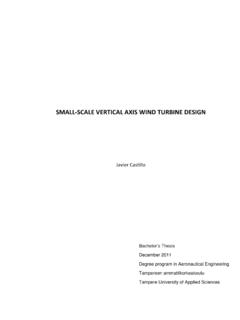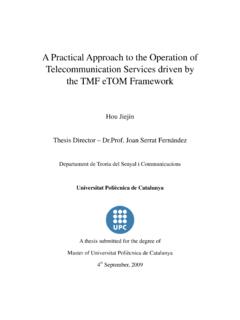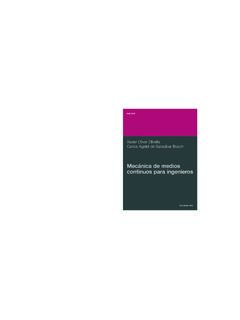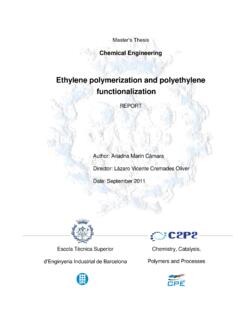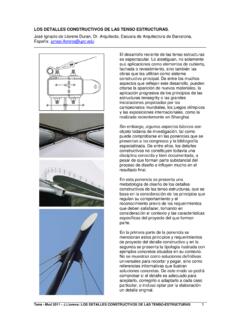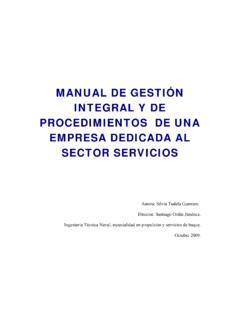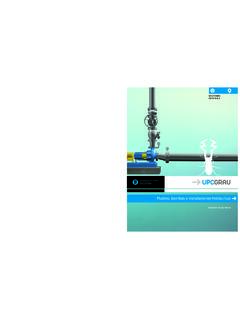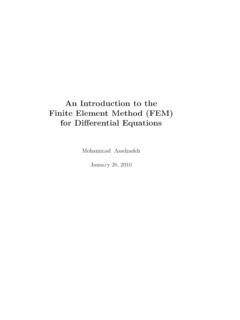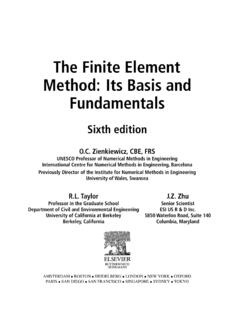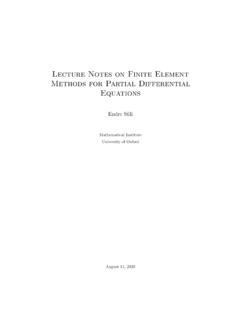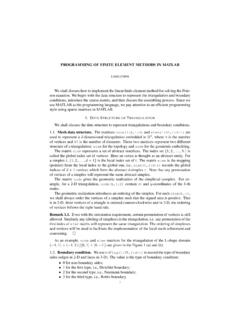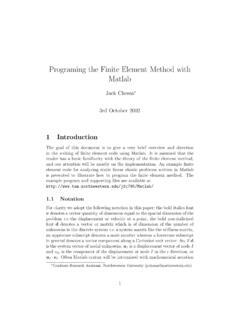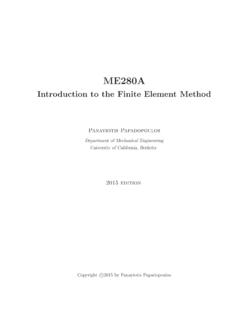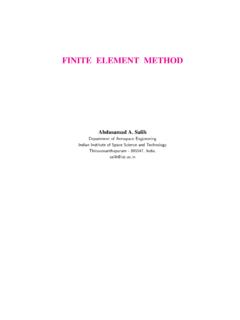Transcription of FINITE ELEMENT ANALYSIS OF STRESSES IN BEAM …
1 Conrad Arnan Ribas FINITE ELEMENT ANALYSIS OF STRESSES IN BEAM STRUCTURES Final project Espoo, Supervisor: Professor Jukka Aalto Instructor: Professor Jukka Aalto Department of Civil and Structural Engineering ABSTRACT AALTO UNIVERSITY SCHOOLS OF TECHNOLOGY PO Box 11000, FI-00076 AALTO ABSTRACT OF THE FINAL PROJECT Author: Conrad Arnan Ribas Title: FINITE ELEMENT ANALYSIS of STRESSES in beam structures School: Engineering Department: Civil and Structural Engineering Professorship: Structural mechanics Code: Rak-54 Supervisor: Jukka Aalto Instructor(s): Jukka Aalto Abstract: This Final project deals with determining of STRESSES in beam structures. First, warping function based on FINITE ELEMENT formulations for determining shear STRESSES at beam cross-sections under biaxial bending and twisting are developed and discretized.
2 Second, FINITE ELEMENT programs for ANALYSIS of beams and three-dimensional frames are developed. These programs, which have been implemented in MATLAB environment, are then combined to a program system, which determines efficiently the combined state of STRESSES at any cross-section of a beam or 3D frame. In order to compare the results of the presented approximate technique to practically exact ones, a program, based on the FINITE prism method, for solving STRESSES in a simply supported prismatic beam has further been developed. The results of the presented technique and FINITE prism method are compared using example problems. In general, closed thin-walled and solid cross-sections give really accurate results, whereas open thin-walled cross-sections do not.
3 Some discrepancies in the shear STRESSES values can be found usually in the points of the beam where any load starts or finishes. Composite cross-sections can be analysed applying this methodology. Finally, applications of the developed program are demonstrated with some more practical examples. Date: Language: English Number of pages: 90 Keywords: FINITE ELEMENT ANALYSIS , 3D frame, Bernoulli-Euler kinematics, warping function, combined stress state, irregular cross-section geometry, composite cross-section FINITE ELEMENT ANALYSIS of STRESSES in beam structures 2 TABLE OF CONTENTS Abstract .. 1 Table of contents .. 2 1 Preface .. 4 2 introduction .. 5 Aims and objectives of the research .. 5 Research methods .. 5 3 FINITE ELEMENT method .. 7 Quadratic isoparametric elements 1-D.
4 7 Biquadratic isoparametric Lagrange elements 2-D .. 9 Numerical integration .. 13 4 Method development .. 15 Assumptions .. 15 Frame ANALYSIS .. 15 FINITE ELEMENT equations of a bar ELEMENT .. 15 Coordinate change .. 24 Global system .. 28 Stress resultants .. 28 Stress distribution .. 28 Cross-sectional properties .. 29 Tension / Compression .. 30 FINITE ELEMENT ANALYSIS of STRESSES in beam structures 3 Biaxial bending .. 31 Shear centre .. 40 Torsion .. 41 General case .. 47 5 Biquadratic FINITE prism method .. 48 Assumptions .. 48 Method description.
5 48 6 Validation of the method .. 62 Comparison between the two methods .. 62 Discussion of the results .. 75 7 Demonstrative examples .. 78 Conclusions .. 84 Acknowledgements .. 86 References .. 87 Appendix .. 89 FINITE ELEMENT ANALYSIS of STRESSES in beam structures 4 1 PREFACE Determining of STRESSES in beam structures is standard teaching material in basic courses on mechanics of materials and structural mechanics [1], [2]. However, there are two topics which are not dealt with enough depth at this level. The first thing is torsion. Torsion of circular and thin-walled hollow shafts and free torsion of thin-walled open cross-sections are usually considered in these texts carefully. introduction to torsion of beams with general cross-section is, however, done using so-called membrane analogy, which is based on stress function formulation of free torsion of a cross-section with general shape [3].
6 This membrane analogy has been chosen in basic teaching texts, because it is an excellent tool in explaining the behaviour of shear STRESSES in a cross-section. The membrane analogy as such cannot, however, give definite numerical results to the shear STRESSES in a twisted cross-section. In order to do this, one should be able to solve the original problem of free torsion. Different formulations of this problem are presented in the literature (for example [3], [5] and [6]). Solution of this problem based on stress function formulation [3] and the FINITE ELEMENT method is well known and demonstrated in reference [4]. This formulation is not, however, straightforward and easy to implement, if the cross-section contains holes. In this context, the warping function formulation [6] is simpler and the corresponding FINITE ELEMENT solution using linear triangular elements has first been presented in reference [7].
7 In this project, the FINITE ELEMENT equations for solving the torsional problem are based on this warping function formulation and biquadratic isoparametric elements [8]. The second thing, which is not tackled through in standard texts on structural mechanics, is shear STRESSES caused by bending. Typically shear flux on any longitudinal section between two parts of the beam can be determined using simple equilibrium consideration. With the help of such shear fluxes average, but not exact, shear STRESSES on the cross-section can further be determined. However, determination of the shear STRESSES distribution caused by bending on a cross-section of any shape is possible. Corresponding formulations have been presented for example in references [3] and [6].
8 FINITE ELEMENT solution based on warping function formulation and using linear triangular elements has been first presented in reference [9]. In this thesis the FINITE ELEMENT equations for solving the bending shear STRESSES are based on this warping function formulation and biquadratic isoparametric elements [10], [11]. FINITE ELEMENT ANALYSIS of STRESSES in beam structures 5 2 introduction AIMS AND OBJECTIVES OF THE RESEARCH The goal in this final project is to develop a FINITE ELEMENT based program in MATLAB environment, which solves the stress resultants of a beam structure and using these, the combined state of STRESSES at any point in this structure. The program thus consists of two main parts. The first part solves the stress resultants of the structure using cubic 1C continuous space frame elements under given loading.
9 The second part performs stress ANALYSIS of the cross-section by combining the effects of axial loading, torsion and biaxial bending using the obtained stress resultants as data. RESEARCH METHODS The space frame program uses typical straight, cubic 1C continuous space frame elements [12] of constant stiffness. The loading consists of linearly distributed axial and transverse load and twisting moment within elements and concentrated loads and moments at the nodes. Although the elements are rather simple, they produce exact solution for the stress resultants at the ELEMENT nodes if the elements are straight and uniform and the loading is just as described. They can also be used in connection with moderately curved beam structures and structures with variable thickness if the FINITE ELEMENT grid is chosen to be sufficiently dense.
10 The program for calculating the cross-sectional STRESSES uses 0C continuous isoparametric biquadratic quadrilateral elements with nine nodes and numerical integration. It calculates the effects of normal force, shear forces, twisting moment and bending moments to the cross-sectional STRESSES and thus obtains the combined state of STRESSES . In order to study the efficiency of the developed technique, a program, based on the FINITE prism method [4], [13], [14] and [15], has also been developed in this thesis. This program is based on three dimensional elasticity equations and does not have the restrictions of classical beam theory. Thus the results obtained using this program give good comparison data for studying the accuracy of the enhanced beam theory of this project.


